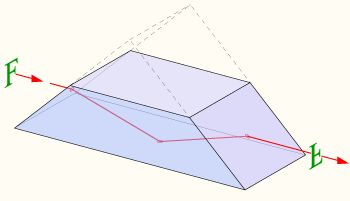.
Dove prism

A Dove prism
A Dove prism is a type of reflective prism which is used to invert an image. Dove prisms are shaped from a truncated right-angle prism. A beam of light entering one of the sloped faces of the prism undergoes total internal reflection from the inside of the longest (bottom) face and emerges from the opposite sloped face. Images passing through the prism are flipped, and because only one reflection takes place, the image's handedness is changed to the opposite sense.
Dove prisms have an interesting property that when they are rotated along their longitudinal axis, the transmitted image rotates at twice the rate of the prism. This property means they can rotate a beam of light by an arbitrary angle, making them useful in beam rotators, which have applications in fields such as interferometry, astronomy, and pattern recognition.
Moreno et. al (2003, 2004) found that there is a change in the state of polarization of a beam of light on passing through a rotated dove prism. The polarization-transforming properties of dove prisms are of particular interest because they can influence the signal measurement of the scientific instrument.
The Dove prism is named for its inventor, Heinrich Wilhelm Dove.
References
* Moreno, i. (2004). Jones matrix for image-rotation prisms. Applied Optics. ISSN 00036935.
* Moreno, i; et. al (2003). Polarization transforming properties of Dove prisms. Optics Communications. ISSN 00304018.
Retrieved from "http://en.wikipedia.org/"
All text is available under the terms of the GNU Free Documentation License

